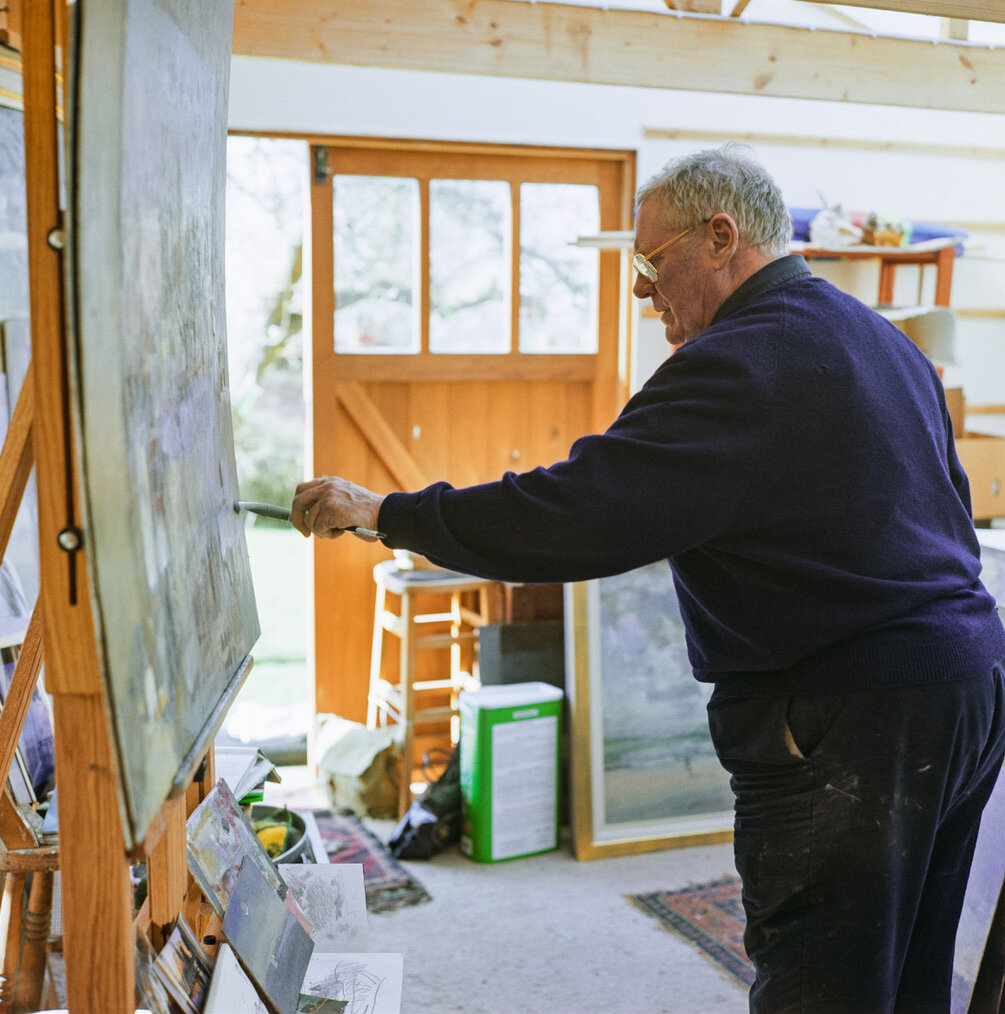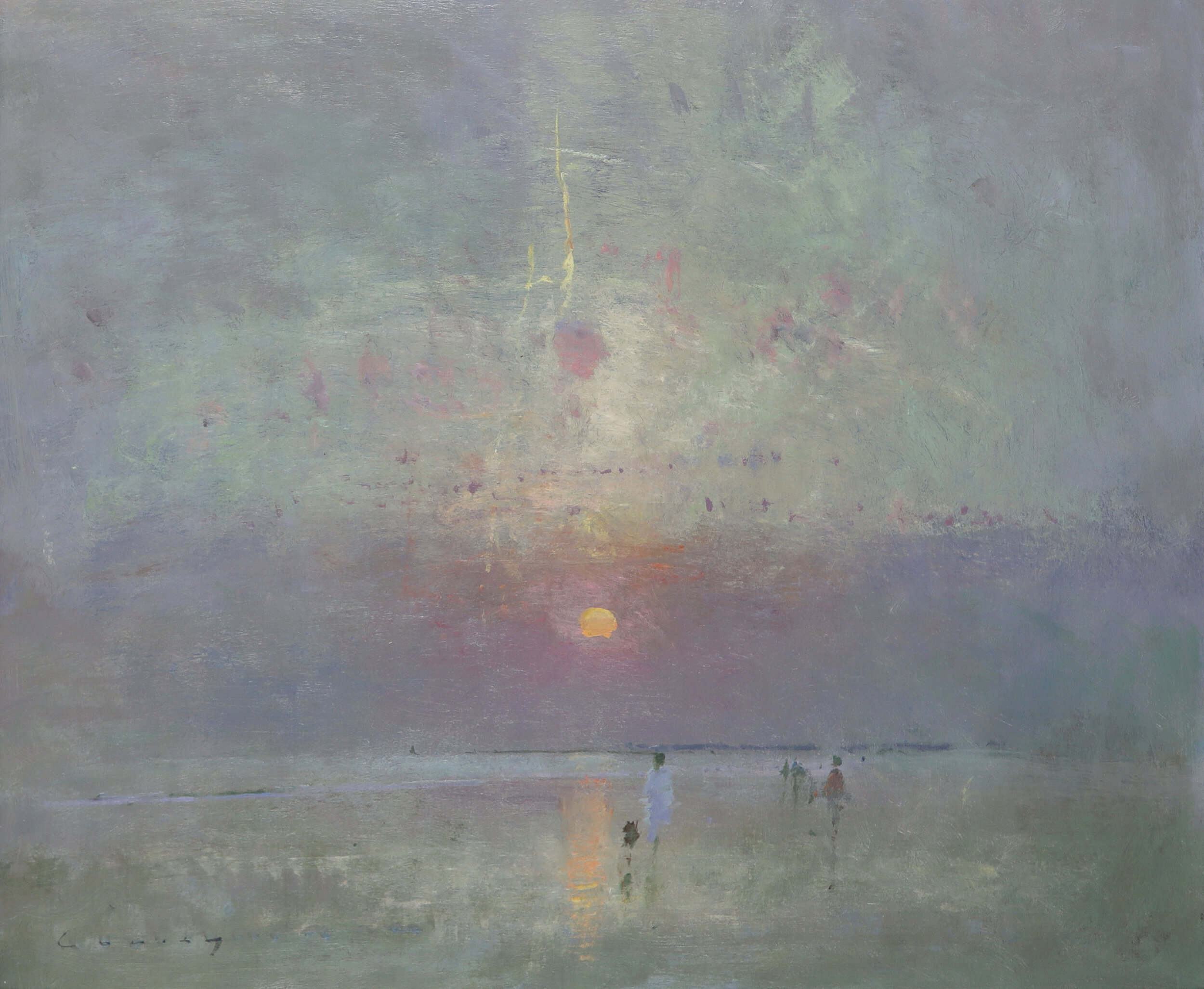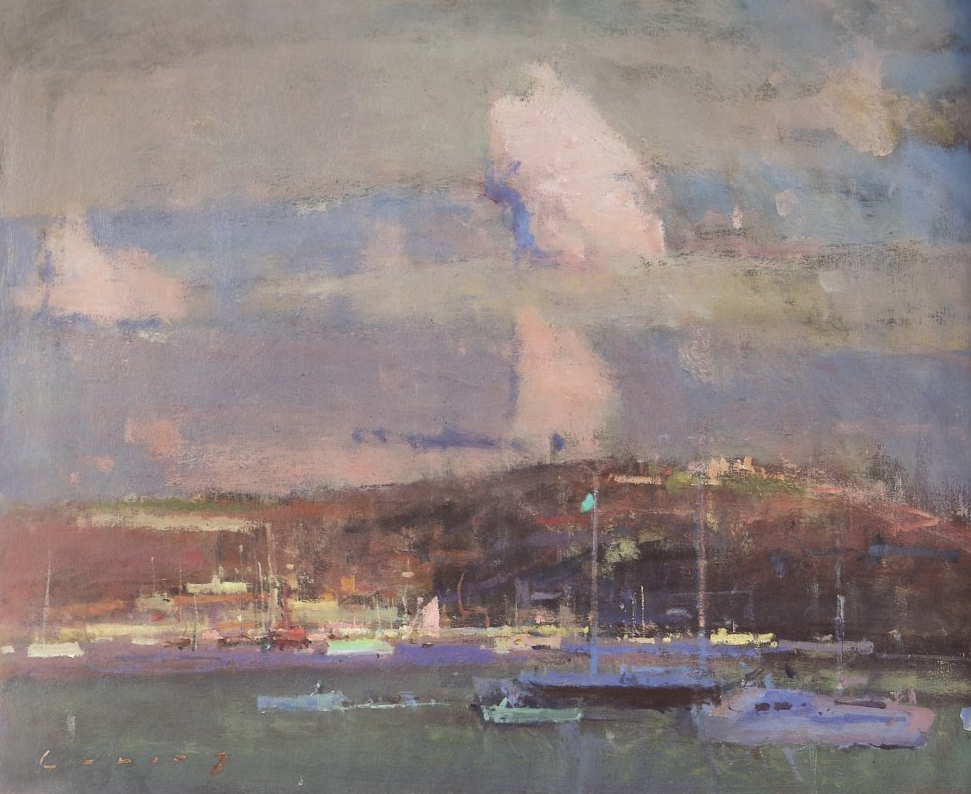Fred Cuming
Legendary British Landscape painter Fred Cuming shares how the more he works the more he discovers.
Tonalism.com: Do you call or think of yourself as a Tonalist or an Impressionist?
Fred Cuming: I think the two aspects are inseparable, to control a painters surface, the balance of colour and tone play supporting roles. Most of my working life has been plein air, except for life studies and interiors. I am not interested in pure representation, my work is about responses to the moods and atmospheres generated by landscape, still life or interior. I am interested in the developments of 20th Century painting, in abstraction, that has been present in all movements, and in new ideas and art forms.
Mr Cuming hard at work in his studio, ©Steve Pyke
Tonalism.com: What’s been the story of your journey as an artist?
Fred Cuming: I was born in 1930, and as a child showed an interest in drawing. I would spend hours down on the river, fascinated by the beautiful old boats and watched the engineers lovingly tend the polished brass of their engines on the free ferry across the Thames in London. These rich and varied themes became the subject of my first attempts at drawing. For my 12th or 13th birthday I was given a set of a dozen small tubes of oil paint which I used on bits of cardboard until my supply ran out. I can still remember that smell.
Fred Cuming
A French teacher at my school in BexleyHeath in England saw that I liked to draw and encouraged my parents to back me up. My Grandfather, a lithographic artist, helped me in my decision to study art. Luckily I was afforded the opportunity to study at the Sidcup School of Art at age 14 where I first gained invaluable experience of drawing life models. My father wanted me to do commercial art but Ruskin Spear - a tutor there - convinced him that I should paint. I had some really good teachers who began to steer me in the right direction - Spear and Edward Ede at Sidcup School of Art, and then when I got to The Royal College my tutor was John Minton, head of painting was Rodrigo Moynihan, Carel Weight, Bobby Buhler, Rodney Burns. They all knew I was interested in landscape and portraits.
My life seems to have been a series of cycles sending me back to something which had a profound effect on me years before.
Tonalism.com: What are the main objectives of your current approach?
Fred Cuming: My latest work has changed little in theme. I find particularly intriguing, while my painting has continued to develop my subjects have not changed much at all. My work is still dominated by the seasons, how they change, how life affects my emotions. Nature provides me with endlessly fascinating problems that convey something which is about nothing more than emptiness.
Fred Cuming
I am fascinated by my surroundings and hope for more changeable weather. I find my work is more dominated by my use of colour and how to achieve a mood by the balances in composition and distribution of colour areas and of course where the human figure is part of the scene. Curiously the amount of work I produce has not diminished, having given myself a reduced target in the number of galleries I show with, this seems to allow me the time to concentrate on the subject of the most importance to me.
Fred Cuming
I continue to be moved and excited by my surroundings, still surprised by the combinations I see before me shapes colors and textures I have never seen before. I've always been particularly drawn to working rivers and ports living near the sea, as I do now. I am confronted by nature's thousand different aspects of moods the problem presented by the simple seascape which is about nothing more than light and space.
Tonalism.com: Please describe a little bit of your painting process
Fred Cuming: My working process is Plein air first - to gather as much information as I can - then after the plein air session I’ll go back to my studio with all the material, the watercolors, drawings and oil studies.
I do some brief sketches and colour notes to begin with, then decisions about composition, balance etc. I begin just by sort of trying to feel out the kind of shapes and the balanced composition, its partly a two-way process of me using paint and working just as when somebody looks at a painting it's a two-way process as well.
Fred Cuming
A piece can be very fresh and have something going for it and then there's so often happens I begin to get bright ideas and then - and then sort of wipe it all out and ruin it .
In terms of working from imagination / on the spot creativity vs exploring reference studies, its a mixture of both as eventually the painting makes the decision by achieving the goal. All my painting is to some extent intuitive. The process at times can hit my target and others may change direction before the result. Sometimes its a failure but this will result in further studies.
My colour palette varies to suit the painting. I always stain my canvases a mid warm colour as I believe Constable did, creating light and dark areas then work towards the composition and colour structure. A painting can become busier and busier and busier and there are times when you know just a few areas of color can speak volumes. Sea, sky, clouds are very very atmospheric.
In my studio I like to be surrounded with images in various stages of development the paintings cross fertilize each other ideas in one can infect another nor is there any fixed sequence for each board or canvas I chop and change my paintings at an alarming rate some are short for long periods others are discarded only for the idea to be picked up again years later. I will sometimes start 3 or 4 versions of an idea taking each in a different direction towards a different interpretation
Fred Cuming
Tonalism.com: Can you describe how you decide on a composition, what makes it feel 'right' to you?
Fred Cuming: First I will make a number of preliminary sketches before making a decision about the final work and others I will have a number of saleable sketches and a final work that pleases me. And at times failure will lead to further attempts. No working process is ever wasted. As Degas said ‘you must approach a work as if you are about to commit the perfect crime’.
Tonalism.com: When would you regard a painting as being finished?
Fred Cuming: I have found over the years the process of painting will lead to further attempts. I distinctly remember a tutor - Carel Weight - in particular telling me ‘that painting is finished you will ruin it if you go on’. I am speaking of my ‘Snowscape and Thorntree’ painted in 1953.
Fred Cuming
Tonalism.com: Could you name any specific influences on your work?
Fred Cuming: Influences on my work have been my tutors, my fellow artists, the early cave paintings, the works of Douanier Rousseau. At the galleries I would head for the Constables or the Turners but out of the corner of your eye you’d see a Cezanne or a Corot and you’d clock onto these and think ‘this is interesting’, and you’d begin to see more. What I love about Giorgio de Chirico is the mysteriousness, the beautiful use of colour. There are so many that are wonderful - 'Piazza d’italia', 'The Red Tower'...
Fred Cuming
Books; ‘The Journal of Eugene Delacroix’. ‘The letters of Theo and Vincent Van Gogh’. Kenneth Clarke ‘Landscape into Art’ in which he talks about how at one point in time landscape was only a background to religious, military or portraiture painting, which then begins to expand into landscape becoming a subject of its own. Lewis Carrols ‘Alice in Wonderland’ and ‘Through the Looking Glass. I love these quotes from Lewis Carroll’s ‘Alice in Wonderland’; ‘Go everywhere with a porpoise’, ‘Start at the beginning and when you come to the end, stop!’ and ‘Retching and writhing and fainting in coils’. The works of Joseph Conrad. ‘Fire on the Moon’ by Norman Mailer. ‘Apocalypse Now’ by Kurt Vonnecut. I’m currently reading Pat Barker ‘Life Class’ which is about the artists of the first world war
Films; Lust for life Van Gogh with Kirk Douglas. ‘The grapes of wrath’, ‘East of Eden’, ‘Of Mice and Men’ by John Steinbeck.
Tonalism.com: Any advice for the aspiring painters?
Fred Cuming: I think it is important to have curiosity. This includes all the architects, inventors, scientists, writers, musicians and artists.
Looking is what makes you grow, practice gives you skill and endless trial and error is what makes you a little bit cleverer each time about what you want to say. Drawing is essential as a tool of discovery; skill and mastery of technique are also essential, but only as a vocabulary and a means towards an idea.
Even after all these years - and I've been painting for more than 60 years now - I still find every new picture exciting including the ones I paint in order to pay the rent. I’m never certain what course a painting will take, will it turn out promising? Be worth returning to when I finish it quickly? Be discarded for being overworked or unworkable? I can never tell but one thing is certain it will give me a great deal of pleasure on the way. The more I discover the more there is left to discover
Tonalism.com: Any final words?
Fred Cuming: It is astonishing how little we really take in of what we see and how little we understand form and structure until we attempt to commit them to paper. The uneducated eye can judge distances, find and avoid objects, do all these things which we need to survive but the artists are in another business altogether.
Some of us are looking for beauty, some are commenting on human life, yet we're all to some extent misunderstood by our contemporaries yet we have no choice but to follow our own star, to pursue that Holy Grail which is there to be won.
Fred Cuming at home in his studio








